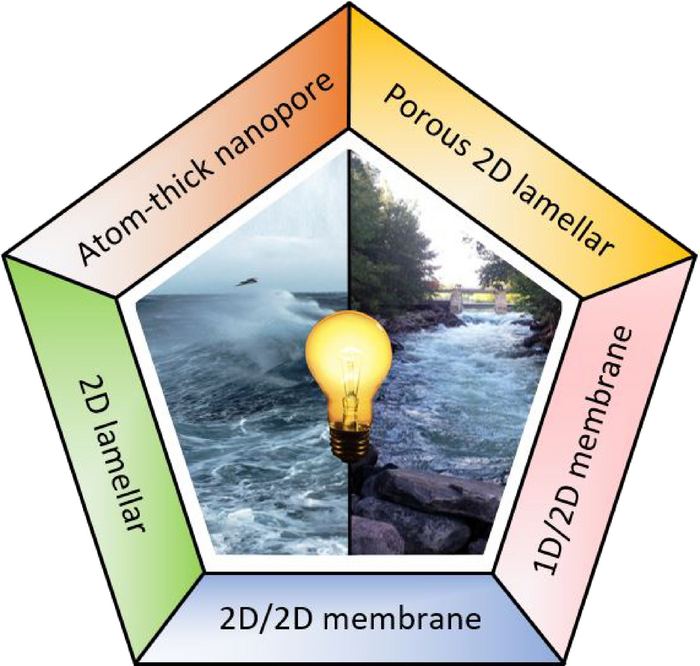Scientists have known since the 1950s that it is theoretically possible to generate electricity through the movement of water at the place where seawater and river water meet. This type of technology is called osmotic power generation or blue energy. Though prototypes of this technology have been built, research is still underway to prove that this technology is scalable and reliable.

Credit: Nano Research Energy, Tsinghua University Press
Scientists have known since the 1950s that it is theoretically possible to generate electricity through the movement of water at the place where seawater and river water meet. This type of technology is called osmotic power generation or blue energy. Though prototypes of this technology have been built, research is still underway to prove that this technology is scalable and reliable.
In a literature review published on May 28 in Nano Research Energy, researchers looked at the different types of materials that can be used in osmotic power generation.
“There are several locations on the earth where the seawater and river water are naturally mixed. The seawater contains positively charged ions such as sodium ions and negatively charged ions such as chloride ions. Utilizing electrostatically charged membranes that are selective to one ion species while blocking the other can generate electricity that can power electronic devices or be stored in batteries,” said paper author Javad Safaei, a researcher at the Centre for Clean Energy Technology at the University of Technology Sydney in Sydney, Australia.
Osmotic power generation is promising as an alternative to fossil fuels for several reasons. Salt water is readily available, the primary waste product of this technique is brackish water and, unlike wind and solar power, electricity produced through this method is not intermittent. Research suggests that around one terawatt, or one trillion watts, could be produced by this method every year. This is in comparison to the global solar output (710 gigawatts) and wind energy output (730 gigawatts), as of 2020.
Because research is moving at such a fast pace, this literature review compared the different types of 2D materials that have been studied for use in osmotic power generation. In order to generate electricity, the water will need to pass through a membrane. If there are two chambers of water with different salinity, the salt water will move through the membrane into the chamber with less salt water. Different types of materials with different properties and benefits can be used as this membrane. The new review paper looked at how the materials were made, their physical characteristics, ion transportation properties, and their ability to generate power through osmosis.
“Currently, these membranes are made by using a variety of materials. Amongst all, 2D materials stand out as the most promising candidate owing to their high ionic conductivities, high mechanical strength, large-scale production capabilities, and the ability to be formed into ultra-thin layers. Furthermore, several nanostructures with enhanced performances can be fabricated by using the hybrid of 2D materials with other nanomaterials,” said Safaei.
Through this review, researchers hope to raise awareness about osmotic power generation through 2D materials. “The most important message we have is to first introduce the concept of converting salt concentration difference of seawater/river water into electricity to a broader audience. We also hope to accelerate the research progress in this field by further specifying the focus on 2D materials, which are the most promising for making high-performance ion-conducting membranes,” said Safaei.
Looking ahead, researchers are hoping to expand the scalability of osmotic power generation using 2D materials, but more research needs to be done. “The 2D materials are currently the most promising classes of materials that can make practical devices that convert the chemical potentials of seawater/river water into electricity. We envision that further research into 2D materials makes practical salinity gradient power generation one step closer to reality,” said Safaei.
Guoxiu Wang at the Centre for Clean Energy at the University of Technology Sydney also contributed to this research.
The Australian Research Council supported this research through the ARC Discovery Projects (Nos. DP200101249 and DP210101389).
##
About Nano Research Energy
Nano Research Energy is launched by Tsinghua University Press, aiming at being an international, open-access and interdisciplinary journal. We will publish research on cutting-edge advanced nanomaterials and nanotechnology for energy. It is dedicated to exploring various aspects of energy-related research that utilizes nanomaterials and nanotechnology, including but not limited to energy generation, conversion, storage, conservation, clean energy, etc. Nano Research Energy will publish four types of manuscripts, that is, Communications, Research Articles, Reviews, and Perspectives in an open-access form.
About SciOpen
SciOpen is a professional open access resource for discovery of scientific and technical content published by the Tsinghua University Press and its publishing partners, providing the scholarly publishing community with innovative technology and market-leading capabilities. SciOpen provides end-to-end services across manuscript submission, peer review, content hosting, analytics, and identity management and expert advice to ensure each journal’s development by offering a range of options across all functions as Journal Layout, Production Services, Editorial Services, Marketing and Promotions, Online Functionality, etc. By digitalizing the publishing process, SciOpen widens the reach, deepens the impact, and accelerates the exchange of ideas.
Journal
Nano Research Energy
DOI
10.26599/NRE.2022.9120008
Article Title
Progress and prospects of two-dimensional materials for membrane-based osmotic power generation
Article Publication Date
28-May-2022




